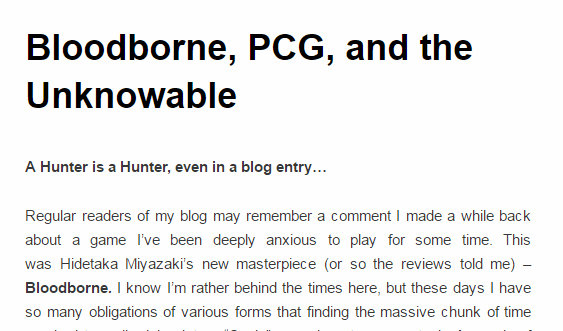
Mark Johnson on Bloodborne, PCG, and the Unknowable
I’ve yet to play Bloodborne–it’s not on the PC, I’m still in the middle of playing through the first Dark Souls, and right now I’m trying to prevent the pirate ship in my NaNoGenMo novel from sailing around in circles–but Mark Johnson took some time out developing Ultima Ratio Regum to write about his reaction to the procedurally-generated bits of Bloodborne.
He’s probably one of the best people on the planet to talk about it right now, since as he says himself he’s spent the past few years building a generative system that is interesting to explore in the same way that From Software’s hand-crafted worlds are interesting to explore.
Generative content that creates deeper meaning is one of my long-standing interests, so this naturally interests me. The weaknesses Mark describes in the Bloodborne generator are more the pity because a Souls-like game seems to be the perfect venue for hiding a deeper structure within the generative content.

As I’ve mentioned in the past, I think that generating progression systems and new gameplay rules are some of the most underutilized areas of procedural generation, since they involve sculpting the systems behind the systems that make things. But generative content is an excellent interface to interact with a with a closed, hypertextual progression system, even if the hypertext isn’t dynamic.
To explain: many game narrative systems are basically hypertext, in the academic sense: text linked to other text. A fetch quest in an RPG is just a complicated way to click on the next link. And we’ve managed to spin some amazing results out of this relatively simple approach.
And generative content can been an effective interface to a hypertextual progression. The surface content presents the ever-changing challenge, while the deeper content gets gradually revealed, as in Moon Hunters.

Mark explicitly namechecks the Abyss and Pandemonium from Dungeon Crawl Stone Soup as good examples of infinite generation–examples I’ve used myself–and points out that some of the reasons why they work is because they’re nearly always hard for the player and because they’re framed as ever-changing, inherently chaotic places.
(Which seems to me would have been perfect for a Souls-game’s nightmare mode of cosmic horror: a level that morphs unpredictably as you play it, geometry oozing into existence: a complete inversion of the deliberately designed spaces in the rest of the game. But to make that really work might require the design from a different game entirely.)
Mark has a lot of other interesting insights, especially if you’re looking to incorporate generative content into your own game. You can read it here: http://www.ultimaratioregum.co.uk/game/2016/11/29/bloodborne-pcg-and-the-unknowable/ (contains spoilers for Bloodborne, naturally)
